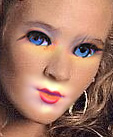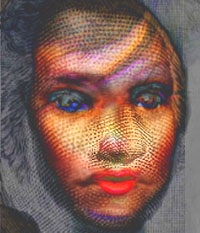| What I Learned from Distorting Barbie |





"Barbie is pure evil steming from the minds of the ones who would like a perfect woman" - email to the Distorted Barbie"We have an intellectual property, not a doll..." Mattel senior counsel
"SHE’S A FUCKING DOLL YOU IDIOTS!" email to the Daily Barbie
I have no confidence in this thing called ‘reality’. I am always suspicious of what exactly is real versus what is imagined, made up, invented, derived from the facts, assumed, presumed, projected, conjectured, conjured, divined or otherwise created by us, in our heads. We talk a lot and we say things that we eventually believe, if we hear them often enough from enough people. “That’s what ‘they’ say” we say. And that’s often all it takes to turn a gauzy thought into a rock hard fact.
"Barbie was more than a doll to me, she was a way of living. Never before or since have I found such an ideal method of living vicariously through anyone or anything." email to the Distorted Barbie"I'm creating a Barbie Hell.. with all kindda nastyness going on, and demons..." email to the Distorted Barbie
Humans are a story telling species. Ants survive by crafting complex nests, bees by making hives, cows by grazing in herds, wolves by hunting in packs. Humans have the distinct skill of crafting stories that last over generations, and use stories to hold knowledge that groups can use to survive. Through images, statues, idols, carved stone, rituals, illuminated manuscripts, handwriting, songs, rhymes, books, film, and TV, to name just the most obvious methods, stories record the decisions a culture has made. Given time a story may become ‘real’. People will believe in the story the way they believe in their couch. Comfortable, familiar, cozy, safe.
"Figurines in huge numbers have been unearthed in most of the Mesopotamian cultures ... Female effigies, made of baked clay or stone ... each about six to eight inches and suitable to be held in the hand." from The Origin of Consciousness, by Julian Jaynes"I think of Barbie as a universally accepted vehicle that kids project their imaginations into - we have an obligation to keep it pure." Mattel Chief Operating Officer.
The name ‘Barbie’ in the world of things and observable facts refers to a jointed assemblage of plastic (vinyl) that fairly accurately resembles a young woman. This object is about eleven inches tall, weighs about 4 ounces, and, despite a few carefully placed joints, is basically rigid. Unlike the possessed Chuckie, Barbie is famously inanimate. In fact, Barbie would be completely unremarkable except for her ability to evoke stories. Maybe it’s her shape (the famous proportions), her features (the trademarked blank stare, or the earlier sultry glance), her history (39 years of toyhood), or perhaps it’s the aggressive marketing ($1.2bn worldwide sales), or a combination of all the above. Perhaps we can’t pin it down, but one need only hand the doll to a child to see storytelling in action.
The doll becomes the main character in a weave of plot, counterplot, metaphor, and drama, all related to and building upon the child’s experience and at the same time reinforcing those experiences. Divorced parents, social strife, heroism, confusion, anger, excitement, fun, and more often than not, sex.
"Our Barbies also danced, pranced and strutted, but mostly they stripped." from What Barbie Really Taught Me by Yona Zeldis McDonoughWhat happens when you hand a Barbie to an adult? Pretty much the same thing. "That slut! Look at those breasts!" "She’s contributing to the moral decline of America." "She’s an independent woman." "She’s obviously bulimic." "She’s a standard of beauty." "That’s the body every man really wants.""I don't know about you, but I always liked my Barbies best in trash, or half naked. Either half." email to the Distorted Barbie
"the unwholesome flexibility of these dolls, their destructive beauty and their semi-nudity have an effect on the minds and morality of young children". from a statement made by Islamic hardliners
They tell stories. The eating disorder people tell stories about eating disorders. The religious right people tell stories about morality. Mattel has their story, and they have the advertising clout to spread it around. Barbie is “wholesome, friendly accessible and kind, caring and protecting, cheerful, fun loving, talented and independent” which contrasts sharply with the story, often told, that Barbie is sleeping with GI Joe, leaving the ineffectual Ken to wash the dishes.
The doll, the plastic homo-replicant, the relatively female humanoid form is the focal point for a battle of fictions, stories told by adults, groups, factions, and movements to defend and propagate the beliefs they hold.
Does Barbie influence thought? Or is it the stories told about the other Barbie, the persona that everybody knows as if she lived next door. Are we the victims of Mattel’s propaganda? Or is Mattel just one more author in the anthology of Barbie short stories? To be influenced by ‘Barbie’, the fiction, the character, the image, is to be influenced by a conglomerate of fictions. The influenced must chose which fictions they will be influenced by. Some girls look at Barbie and decide to enlarge their breasts. Others take Barbie to Dads workshop and power-sand her back to androgyny. Same doll. Different responses.
"As you may know, Mattel owns the character BARBIE ... There can be no dispute that this page unlawfully infringes Mattel’s copyrights" an attorney for Mattel"What I do in my job, first and foremost, is protect Barbie." Jill Barad, Mattel CEO.
In October 97 I received a cease-and-desist letter from an attorney representing Mattel, demanding that I remove my website (The Distorted Barbie) from the web. What followed was a lesson in the power of stories. Corporations will fight to preserve those fictions that they believe best sell their products. These fictions, after all, translate into real choices and real purchases. Did Mattel create these fictions, or are these the fictions that call our culture to consume in 1998? The cash register is a voting booth. Every dollar spent represents a belief, a buying in to a marketing fiction. Stories represent profit. Stories represent lifestyles and values. These are potentially valuable properties.
"I think maybe you take Barbie too seriously, but then a lot of people do" email to the Distorted Barbie
At this point my brain does this doublejointed schizophrenic association and I find myself thinking of Jesus. I was raised Catholic, and spent six years in a Catholic shool. I was powerfully exposed to the history of the life of Jesus. Although I am no closer to meeting Jesus in the flesh than I am to, say, meeting Zeus, I still find it way easier to say “Zeus is a myth” than to say “Jesus is a myth”, even though both are stories in my experience. But for me, Jesus will always straddle the line between fact and fiction.
Perhaps that's the common thread to these lasting stories. Jesus and Barbie are both characters that exist as fictions in our culture. The stories far outreach the literal facts of these two icons. They both blur the line between what exists, and what is invented. And that’s the power of a really good story.